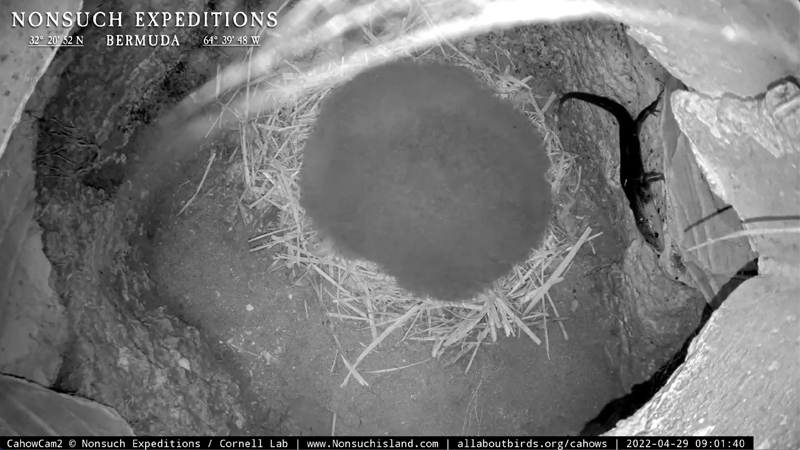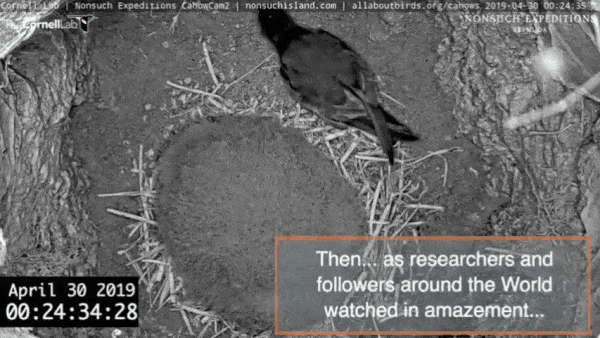Endangered Species Skinks & Cahows Interact
As the world marks ‘Endangered Species Day,’ Nonsuch Expeditions is highlighting two of Bermuda’s IUCN Red Listed species — the cahow and skink — noting that the two critically endangered species are interacting on Nonsuch Island where they can “thrive without the threat of introduced predators.”
Senior Terrestrial Conservation Officer Jeremy Madeiros, head of the Cahow Recovery Project, has observed something remarkable this year – as he records the highest number of chicks ever in the Cahow breeding colony on Nonsuch Island, the population of another critically endangered animal is increasing too: the endemic Bermuda skink.
Screenshot from a video showing a Bermuda skink in a cahow’s nest
“It seems that where Cahows nest, skinks tend to be doing better too,” Mr Madeiros says.
He believes it is likely that the Bermuda skink co-evolved with the Cahows and Audubon’s shearwaters that used to live in vast breeding colonies on Bermuda’s islands, and that the skink’s success may be tied to the Cahows.
“Thanks to a 60+ year rewilding effort that has seen Nonsuch Island restored to pre-colonial Bermudian habitat, allowing Cahows and skinks to thrive without the threat of introduced predators, we can observe these two critically endangered species interacting once more.”
“The skinks spend time in and around Cahow burrows – and the birds don’t seem to mind,” Nonsuch Expeditions Founder and CahowCam creator Jean-Pierre Rouja says, as has been documented in footage from the CahowCams, his special camera set ups that allows video from inside the underground nesting burrows to be broadcasted to the world without disturbing the birds.
In the video below from 2019 the skink arrives around the 1:47 mark.
“Why do the skinks want to cozy up with the fluffy chicks? Likely to take advantage of the safe shelter of their underground burrows, and to forage for food. Skinks have a very variable diet, including fruit, insects, and carrion.
“They occupy a cleaning role in Cahow nests, eating insects like ants that bother the chicks. They will also eat spilled food and bird droppings, and when an egg fails or a chick dies, they will go in rapidly and scavenge it.
“They provide a valuable function for the Cahows, keeping nest burrows disease free. They’re like little live-in housekeepers almost. They benefit from the shelter, and in turn they keep the nests nice and clean and healthy,” Mr Madeiros explained.
“Living in a Cahow burrow probably gave skinks a better chance of survival when they first colonized Bermuda, likely by travelling over the ocean on floating debris, about 400,000-2 million years ago. Through re-establishing the Cahow, this ancient relationship has also been reconnected.”
Extract from the video above showing the skink ‘visiting’ the cahow
A conservation team in New Zealand had a similar story, Mr Madeiros said.
“In areas where they were increasing shearwater populations [a ground-nesting bird related to the cahow], tuataras also increased – a reptile endemic to the area that’s kind of like a cross between a lizard and a dinosaur.
“The tuataras used the burrows for shelter, and the birds were not bothered by the lizards. Now we can see a similar thing going on with the skink in Bermuda. It seems more and more obvious that Cahows and skinks have had this semi-symbiotic relationship for thousands of years – perhaps millions.”
On the Bermuda mainland, skinks are now only found in small, fragmented populations in specific habitats. On Nonsuch, Mr Madeiros says the skink populations located away from the Cahow colony have plateaued or even decreased, while those living close to the Cahows have skyrocketed.
“There were only 7 or 8 skinks living where the main Cahow colony is on Nonsuch Island in 2009. Now, 12 years later, I would estimate we have 50-60, possibly 70 living there,” he said.
The next step will be for Mr Madeiros to ground proof his empirical observations by conducting another skink survey, which will involve trapping the skinks and determining their population numbers.
“It’s a nice little symbiosis. The Cahow recovery plan has unintended beneficial side effects – we are even helping other species as well,” he said.
To learn more about the work being done by Nonsuch Expeditions, visit their website.
Read More About
Category: All, Environment, News




